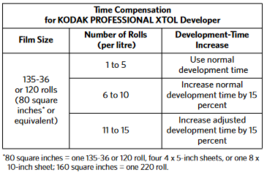Sirius, something is not right. Either you are not mentioning some critical detail, or just not telling the whole story. Because my personal experience measuring control strips, Kodak datasheets, and common sense will all say: if you always, 100% of the time, replenish with exactly 70ml, the activity level will drift. Periodic adjustments are required if you want consistent results.
This is true for all replenished systems, because the amount of byproduct released back into a working developer varies with film speed, film manufacturer, exposure and subject matter. Unless you shoot the same grey card on HP5+ and develop exactly the same number of rolls per week, you cannot possibly have a stable solution by replenishing with a fixed amount.
Here are my control strip readings showing the swings. Normally I replenish with the same amount, but I had to make 4 corrections since March 2022:
| Date |
DMax |
DMin |
LD |
HD |
HD-LD |
| 03/29/2022 |
1.53 |
0.29 |
0.38 |
1.08 |
0.7 |
| 06/11/2022 |
1.71 |
0.29 |
0.41 |
1.22 |
0.81 |
| 10/17/2022 |
1.58 |
0.28 |
0.37 |
1.10 |
0.73 |
| 02/12/2023 |
1.61 |
0.28 |
0.4 |
1.14 |
0.74 |
| 06/19/2023 |
1.54 |
0.29 |
0.38 |
1.09 |
0.71 |
The activity jumps were caused by batches of low speed film exposed after a vacation/event, or just different film, i.e. not HP5+ which is my usual. I do not shoot films faster than ISO 400 and never push, maybe that's my activity level never dipped.






